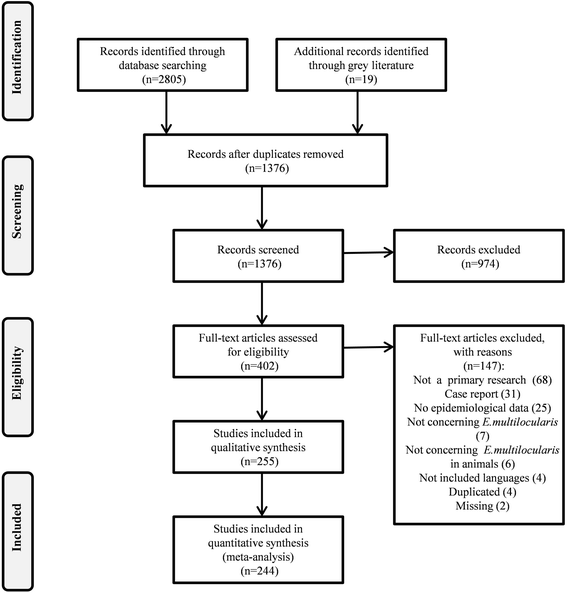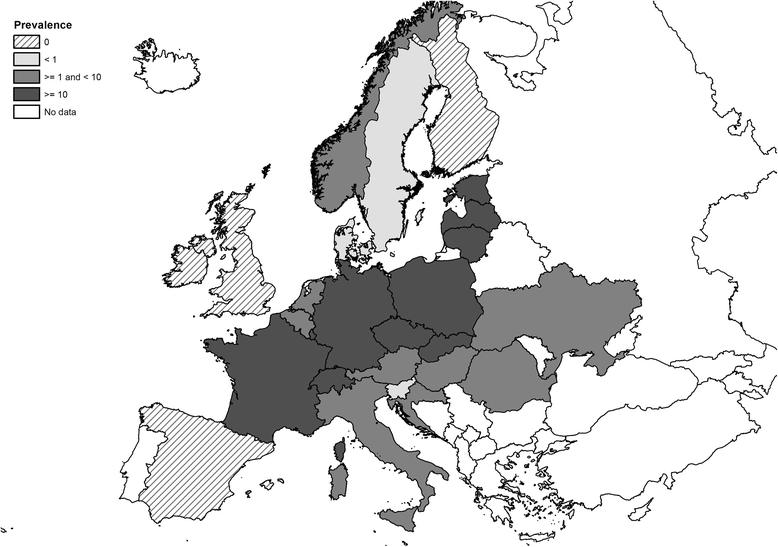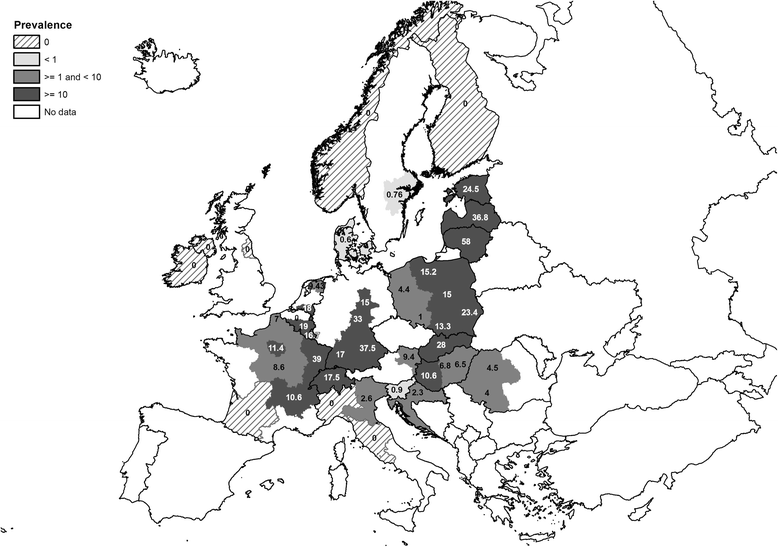The geographical distribution and prevalence of Echinococcus multilocularis in animals in the European Union and adjacent countries: a systematic review and meta-analysis
- PMID: 27682156
- PMCID: PMC5039905
- DOI: 10.1186/s13071-016-1746-4
The geographical distribution and prevalence of Echinococcus multilocularis in animals in the European Union and adjacent countries: a systematic review and meta-analysis
Abstract
Background: This study aimed to provide a systematic review on the geographical distribution of Echinococcus multilocularis in definitive and intermediate hosts in the European Union (EU) and adjacent countries (AC). The relative importance of the different host species in the life-cycle of this parasite was highlighted and gaps in our knowledge regarding these hosts were identified.
Methods: Six databases were searched for primary research studies published from 1900 to 2015. From a total of 2,805 identified scientific papers, 244 publications were used for meta-analyses.
Results: Studies in 21 countries reported the presence of E. multilocularis in red foxes, with the following pooled prevalence (PP): low (≤ 1 %; Denmark, Slovenia and Sweden); medium (> 1 % to < 10 %; Austria, Belgium, Croatia, Hungary, Italy, the Netherlands, Romania and the Ukraine); and high (> 10 %; Czech Republic, Estonia, France, Germany, Latvia, Lithuania, Poland, Slovakia, Liechtenstein and Switzerland). Studies from Finland, Ireland, the United Kingdom and Norway reported the absence of E. multilocularis in red foxes. However, E. multilocularis was detected in Arctic foxes from the Arctic Archipelago of Svalbard in Norway.
Conclusions: Raccoon dogs (PP 2.2 %), golden jackals (PP 4.7 %) and wolves (PP 1.4 %) showed a higher E. multilocularis PP than dogs (PP 0.3 %) and cats (PP 0.5 %). High E. multilocularis PP in raccoon dogs and golden jackals correlated with high PP in foxes. For intermediate hosts (IHs), muskrats (PP 4.2 %) and arvicolids (PP 6.0 %) showed similar E. multilocularis PP as sylvatic definitive hosts (DHs), excluding foxes. Nutrias (PP 1.0 %) and murids (PP 1.1 %) could play a role in the life-cycle of E. multilocularis in areas with medium to high PP in red foxes. In areas with low PP in foxes, no other DH was found infected with E. multilocularis. When fox E. multilocularis PP was >3 %, raccoon dogs and golden jackals could play a similar role as foxes. In areas with high E. multilocularis fox PP, the wolf emerged as a potentially important DH. Dogs and cats could be irrelevant in the life-cycle of the parasite in Europe, although dogs could be important for parasite introduction into non-endemic areas. Muskrats and arvicolids are important IHs. Swine, insectivores, murids and nutrias seem to play a minor or no role in the life-cycle of the parasite within the EU and ACs.
Keywords: Echinococcus multilocularis; Europe; Geographical distribution; Prevalence; Systematic review.
Figures



References
LinkOut - more resources
Full Text Sources
Other Literature Sources
Miscellaneous

